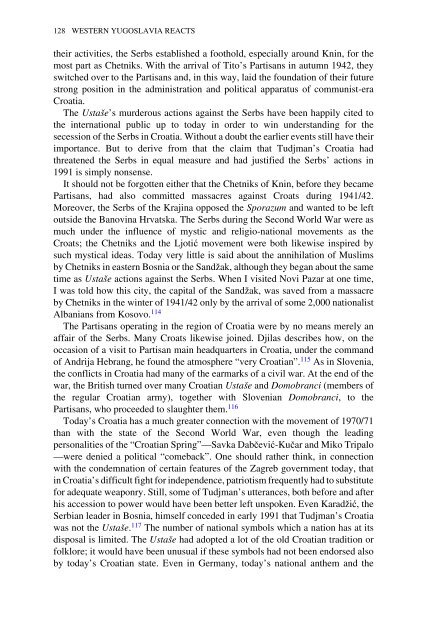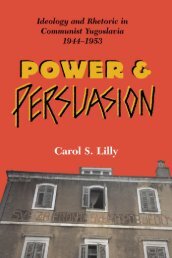Yugoslavia: A History of its Demise - Indymedia
Yugoslavia: A History of its Demise - Indymedia
Yugoslavia: A History of its Demise - Indymedia
You also want an ePaper? Increase the reach of your titles
YUMPU automatically turns print PDFs into web optimized ePapers that Google loves.
128 WESTERN YUGOSLAVIA REACTS<br />
their activities, the Serbs established a foothold, especially around Knin, for the<br />
most part as Chetniks. With the arrival <strong>of</strong> Tito’s Partisans in autumn 1942, they<br />
switched over to the Partisans and, in this way, laid the foundation <strong>of</strong> their future<br />
strong position in the administration and political apparatus <strong>of</strong> communist-era<br />
Croatia.<br />
The Ustaše’s murderous actions against the Serbs have been happily cited to<br />
the international public up to today in order to win understanding for the<br />
secession <strong>of</strong> the Serbs in Croatia. Without a doubt the earlier events still have their<br />
importance. But to derive from that the claim that Tudjman’s Croatia had<br />
threatened the Serbs in equal measure and had justified the Serbs’ actions in<br />
1991 is simply nonsense.<br />
It should not be forgotten either that the Chetniks <strong>of</strong> Knin, before they became<br />
Partisans, had also committed massacres against Croats during 1941/42.<br />
Moreover, the Serbs <strong>of</strong> the Krajina opposed the Sporazum and wanted to be left<br />
outside the Banovina Hrvatska. The Serbs during the Second World War were as<br />
much under the influence <strong>of</strong> mystic and religio-national movements as the<br />
Croats; the Chetniks and the Ljotić movement were both likewise inspired by<br />
such mystical ideas. Today very little is said about the annihilation <strong>of</strong> Muslims<br />
by Chetniks in eastern Bosnia or the Sandžak, although they began about the same<br />
time as Ustaše actions against the Serbs. When I visited Novi Pazar at one time,<br />
I was told how this city, the capital <strong>of</strong> the Sandžak, was saved from a massacre<br />
by Chetniks in the winter <strong>of</strong> 1941/42 only by the arrival <strong>of</strong> some 2,000 nationalist<br />
Albanians from Kosovo. 114<br />
The Partisans operating in the region <strong>of</strong> Croatia were by no means merely an<br />
affair <strong>of</strong> the Serbs. Many Croats likewise joined. Djilas describes how, on the<br />
occasion <strong>of</strong> a visit to Partisan main headquarters in Croatia, under the command<br />
<strong>of</strong> Andrija Hebrang, he found the atmosphere “very Croatian”. 115 As in Slovenia,<br />
the conflicts in Croatia had many <strong>of</strong> the earmarks <strong>of</strong> a civil war. At the end <strong>of</strong> the<br />
war, the British turned over many Croatian Ustaše and Domobranci (members <strong>of</strong><br />
the regular Croatian army), together with Slovenian Domobranci, to the<br />
Partisans, who proceeded to slaughter them. 116<br />
Today’s Croatia has a much greater connection with the movement <strong>of</strong> 1970/71<br />
than with the state <strong>of</strong> the Second World War, even though the leading<br />
personalities <strong>of</strong> the “Croatian Spring”—Savka Dabčević-Kučar and Miko Tripalo<br />
—were denied a political “comeback”. One should rather think, in connection<br />
with the condemnation <strong>of</strong> certain features <strong>of</strong> the Zagreb government today, that<br />
in Croatia’s difficult fight for independence, patriotism frequently had to substitute<br />
for adequate weaponry. Still, some <strong>of</strong> Tudjman’s utterances, both before and after<br />
his accession to power would have been better left unspoken. Even Karadžić, the<br />
Serbian leader in Bosnia, himself conceded in early 1991 that Tudjman’s Croatia<br />
was not the Ustaše. 117 The number <strong>of</strong> national symbols which a nation has at <strong>its</strong><br />
disposal is limited. The Ustaše had adopted a lot <strong>of</strong> the old Croatian tradition or<br />
folklore; it would have been unusual if these symbols had not been endorsed also<br />
by today’s Croatian state. Even in Germany, today’s national anthem and the
















